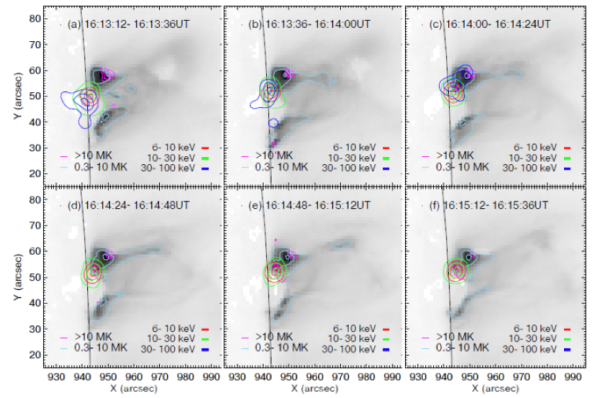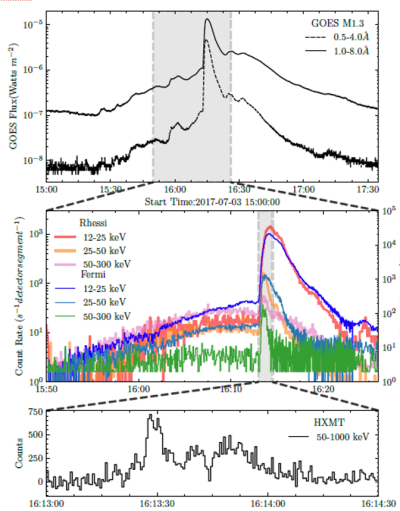Solar Hard X-rays with Insight
| Nugget | |
|---|---|
| Number: | 428 |
| 1st Author: | Wei WANG |
| 2nd Author: | Ping ZHANG |
| Published: | 21 March 2022 |
| Next Nugget: | CME with 3D Velocities |
| Previous Nugget: | Probing chromospheric current sheets using SST and ALMA co-observations |
k
Introduction
This Nugget reports solar observations from the Insight/HXMT hard X-ray/gamma-ray observatory, launched 15-Jun-2017 (ref. [1]). Its three major instruments cover low, medium, and high energies with large effective areas, and it arrived in orbit in time to observe the major flare SOL2017-09-06 (Ref. [2]). Its instruments use modulation optics, as did RHESSI, but at degree-scale angular resolutions and thus not helpful for details of solar sources. This Nugget reports another interesting flare at the limb, SOL2017-07-03 (M1.3), observed also by RHESSI and Fermi/GBM (Figure 1)
Observations of SOL2017-07-03
The observations reveal a footpoint-occulted flare with bright impulsive hard X-ray emission (Figure 1), but interestingly not much flux at 100 keV. AIA 131 Å images show a fine stable plasma filament (Figure 2(A/B/C)(, and a mini-cusp structure appearing at the peak of the hard X-ray phase, plus a filament eruption. We did not see a loop-top hard X-ray source in this case, and only a single footpoint region (north). The non-detection of a south footpoint region suggests electron energy losses in the lower atmosphere. Hard X-rays above the 50-100 keV band were not detected by RHESSI. by the RHESSI detector, and the absence of coronal emission suggests no effective trapping. This scenario is supported by emission measure maps (Figure 3) derived from SDO/AIA data in the manner discussed in Ref. [3].


In a flare such as this one, we envision lower-coronal magnetic reconnection releasing vast amoutns of energy, heating the ambient cooler plasma and simultaneously accelerating electrons. The hard X-ray spike is very short, though; only about 30 s above 50 keV, as shown in Figure 1. This and the imaging imply an acceleration site very close to the bottom of the corona. In some manner the dissipation of this energy injected hot plasma into large-scale loops loops, without significant nonthermal signatures.
Conclusion and Summary
Different hard X-ray telescopes provide the insight to the particle accelerations and high energy emission properties in flares, and the joint X-ray observations of multiple instruments should be very helpful to understand the energy conversion and plasma response during the flares in wide energies and large spatial ranges. The Insight/HXMT solar observations can play a role in this owing their unique properties.
References
[1] "Overview to the Hard X-ray Modulation Telescope (Insight-HXMT) Satellite"
[3] "X-ray fine structure of a limb solar flare revealed by Insight-HXMT, RHESSI and Fermi"
